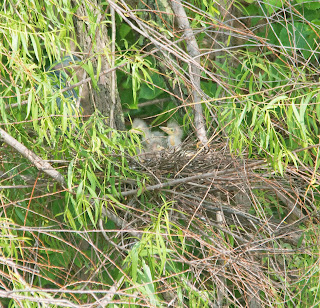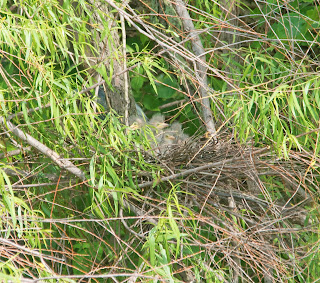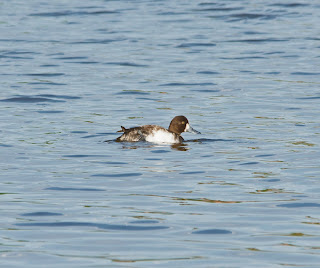Translate
Sunday, May 26, 2019
Saturday, May 25, 2019
Pre- and Post Flood Natural Birding Wonders
Dickcissel
051919
One of many of these birds found at Sooner Lake. This was one of the few days that it didn't rain, providing a wonderful day birding.
Swainson's Thrush
Savannah Sparrow
052319
This was a couple of days after the flood. This beautiful Swainson's Thrush sat out in the open in the current swampy area, where I also located a late-migrating Rose-breasted Grosbeak, a singing male Common Yellowthroat, and both Alder and Least Flycatchers.
The Savannah Sparrow is known as a later sparrow migrant, providing a couple of nice shots in a drier area.
The lake had receded slightly, but it still was not completely back within its banks.
First Green Heron Clutch of the Year Comes to Boomer Lake
05-25-19
0700-0857/partly cloudy/S-12/87-75% RH/30 Hg and rising to 30.09 Hg and steady--shortly after early morning rain
Both proud parents were tending and feeding their young this morning. There were four nestlings discovered at approximately 0700 hrs. this date.
Suspicions that there were or would soon be young were raised yesterday, as the parent(s) were sitting much higher on the nest.
It is true, as can be seen, that young Green Herons really do have green skin. The young will be protected until most of their feathers grown in, as tender young skin will be subject to sunburn.
Once again, we are parents, and may the weather stay cooler for these young birds, as it has been. This is the first year that a Green Heron nest has been fully visible and at eye level.
Wednesday, May 22, 2019
Storms of 2019 Flood Boomer Lake and Beget Shorebirds Galore
Hooded Merganser (Right)
Ruddy Duck (Left)
Female Hooded Merganser
Ruddy Shelduck
Willow Flycatcher
White-rumped Sandpipers
White-rumped Sandpiper
Semipalmated Sandpiper
Ruddy Turnstone ( Center of Group)
Franklin's Gull (Center)
Black Tern
Franklin's Gull (Bottom)
Forster's Terns
052119
0855-1012 hrs/65-66 F/mostly cloudy/89% RH--shortly after heavy rain stopped
A few dozen Canada Geese were in the arms of safety on the southeast corner of the our beloved Boomer Lake with low areas growing in size with water, which had two or three Mallards swimming within. Three Great Blue Herons were seen in transit from all directions.
Beloved Boomer was flooded to the mow line and police units were out to deter traffic in flood areas on the west side. Heron Cove was my biggest worry, with the Green Heron nest just over the water and in full view.
Relaxing a little when I observed Mother Heron upon her nest, fast asleep, wet and bedraggled, the stick fortress was sinking lower just above water. Two Willow Flycatchers were heard on the Cove, one safely hidden, yet obviously fearful and calling from the mulberry bush at The Cove. On the west side of Heron Cove was a female Hooded Merganser near shore with a sleeping Ruddy Duck. A Baltimore Oriole was in attendance, along with plenty of Great-tailed Grackles, a Common Grackle, and an Eastern Kingbird could be heard, while a Brown Thrasher was atop the trees, having taken sentry duties. A yellow-shafted Northern Flicker always seemed to be foraging in front of me, always just ahead to pave the way.
At least one southwest jetty was nearly covered by water, yet the southeastern jetty was close to the same with a twelve-foot span toward the end of the cove submerged. Franklin's Gulls could be observed, giving writer a good idea that there were shorebirds there.
On the way to the southeastern jetty, several familiar areas were choked with excess water with at least two more Willow Flycatchers flitting about in a normal nervous manner. All birds were doing their best to stay above the rushing water line. Mourning Doves were performing their plaintive wail atop the new power lines. Ducks, both wild and domestic, and Canada Geese were going about their business foraging in wet grass.
Rounding the corner to reach the jetty, a friend was scoping the area. He had come up with most of the photographed birds. While we inched closer to these birds, he was walked beside me, telling me what he had observed. We both continued to get as close as possible without driving the shorebirds and gulls away. Upon approach, Black Terns were flying by closer than I had ever seen them, allowing wonderful observation of behavior.
The real question was nearest the bench at the end of the jetty, breached by several feet of standing water. Was there a Common Tern among the Forester's Terns? It turned out to be a false alarm, but this was a fabulous search for shorebirds, some of which I had never before seen in Oklahoma.
My standing joke has always been that birds that have never been here eventually come to see me and they Payne County list grows.
Sunday, May 19, 2019
051919 SNP Edition, Life at Boomer Lake
Friday, May 17, 2019
Secret Lives of Birds and the Mulberry Bush
Scissor-tailed Flycatcher
Canada Gosling
Cedar Waxwing
Northern Cardinal
Swainson's Thrush
American Robin
Week of 051319
Another seven days of productive migratory and resident bird views. As can be observed, the mulberry bush drew in a lot of birds, even during nesting season. However, young birds like nestlings, fledglings and juveniles require protein, not the adults. The young need food to help them rapidly grow, so they can migrate, if necessary.
However, the mulberry allowed many adults to capitalize on sweet treats while they were working hard to feed young.
Wednesday, May 15, 2019
First Week of May 2019 Boomer Migrants
Summer Tanager
Clay-colored Sparrow
050219
The above birds were coming through for migration. The two Summer Tanagers were at Heron Cove for two days, and the Clay-colored Sparrows stayed for several days, perhaps up to a week.
White-throated Sparrow
050319
This beautiful White-throated Sparrow visited for a day, along with several other varieties.
Cedar Waxwing
050419
This Cedar Waxwing is an irruptive, yet they can be counted on to arrive nearly every year, as of late. This was a very strong year, and at this time, I am not convinced that they will remain irruptive long. Since the northern winters are only getting worse, we may find these visitors to be predisposed to range expansion.
Green Heron On Nest
050519
This was the first day that I actively searched for a nest in order to not disturb the three Green Herons.
The nest is the lowest that I have ever seen it, though within normal parameters. Two eg were originally discovered, but I believe there are three as of this posting.
Female Ring-necked Duck
This duck was with Northern Shovelers and Blue-winged Teal. There were a total of two Ring-necked Ducks on this date.
Male Northern Shoveler
The group of males were feeling there oats and very intensely affected by a testosterone flow. Some were more combative with one another than some. The few females ignored most of the battles.
Blue-winged Teal Pair
This lovely pair is a nice example of Blue-winged Teal in breeding plumage.
Male Northern Shoveler
This photo shows a nice view of the beautiful colors of a male in breeding plumage.
Willets
050619
Originally observed from the west end of Heron Cove, I was unable to determine what these large shorebirds were until I got much closer. At a total of 18, these were beautiful examples of a migratory group of Willets not often seen at Boomer Lake.
Sunday, May 12, 2019
Thursday, May 9, 2019
Birding on a Shoestring: Amistad, Cook's Slough, Rincon Del Diablo and More
Cliff Swallows, View 1
Cliff Swallows, View 2
Cliff Swallows, View 3
Wild Nicotiana
Verdin Nest
Canyon Wren
Strawberry Cactus
04-26-19 Amistad National Recreation Area is a very diverse area that afforded many wonderful opportunities for viewing both plants and wildlife. Across the Rio Grande River in Mexico, Great Blue Herons were observed nesting on the cliffs. Turkey and Black Vultures, as well as a Red-tailed Hawk were observed riding the warm air thermals. Many birds, as well as the beautiful nesting Cliff Swallows in natural habitat, were found nesting here, as well as the Canyon Wren on the face of the cliffs.
Brown-crested Flycatcher
04-26-19 Rincon Del Diablo is private property that I was permitted entrance to bird with area residents. Our search began with a Zone-tailed Hawk (observed), as well as this lovely Brown-crested Flycatcher that I have been trying to properly photograph for a few years. The long-term quest was the Morelet's Seedeater (formerly named the white-collared Seedeater), but we were not successful.
Swan Goose
Black Vulture
04-27-19 Cook's Slough, Uvalde, TX
This natural birding area is home to some of the finest birding in Uvalde County. With 25 acres of land and two viewing stations, it is a prime resource for many birds and mammals.
Rufous-crowned Sparrow
Black Vultures and Axis Deer
Black-crested Titmouse
04-27-19 Neal's Lodgings, Concan, Texas
This was a camping area that had a lot of birds in the area. It had been suggested as a location to possibly observe the rare, Yellow-cheeked Warbler, which we did. Again, I didn't catch a photo opportunity, but there were other things to photograph.
Subscribe to:
Comments (Atom)























































